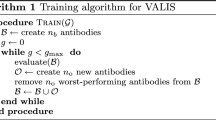Abstract
We use a modified version of the CLONALG algorithm to perform exploratory data analysis. Since we wish to compare results from a number of methods, we only report on linear projections which have unique solutions. We incorporate a type of Gram Schmidt orthogonalisation [15] into the affinity maturation process to capture multiple components. We combine the new algorithm with reinforcement learning [17, 20] and with cross entropy maximization [13, 19]. Finally we combine several different non-standard adaptation methods using bagging and show that we get reliable convergence to accurate filters.










Similar content being viewed by others
References
Ada GL, Nossal GJV (1987) The clonal selection theory. Sci Am 257(2):50–57
Breiman L (1996) Bagging predictors. Mach Learn 24(2):123–140
Breiman L (1999) Using updaptive bagging to debias regression. Technical Report 547, Statistics Department, University of California
Burnet FM (1959) The clonal selection theory of acquired immunity. Cambridge University Press, Cambridge
Burnet FM (1978) Clonal selection and after. Theor Immunol 300(19):1105–1107
Cichocki AA, Yang HH (1996) A new learning algorithm for blind signal separation. Adv Neural Inf Process Syst 8:757–763
de Castro LN, Von Zuben FJ (2002) Learning and optimization using the clonal selection principle. IEEE Transaction on evolutionary computation, special issue on artificial immune systems, vol 6, pp 306–313
Dybowski R, Roberts S (2001) Confidence intervals and prediction intervals for feed-forward neural networks. Cambridge University Press, Cambridge
Efron B, Tibshirani R (1993) An introduction to the bootstrap. Chapman and Hall
Fan CY, Wang BQ, Ju H (2006) A new fastica algorithm with symmetric orthogonalization. In: Communications, circuits and systems proceedings, 2006 international conference, June, vol 3, pp 2058–2061
Hyvarinen A, Karhunen J, Oja E (2001) Independent component analysis. Wiley
Jolliffe IT (1986) Principal component analysis. Springer
Kroese DP, Rubinstein RY (2004) The cross entropy: a unified approach to combination optimization, Monte-Calo simulation and mechine learning. Spinger
Lai PL (2002) Neural implementations of canonical correlation analysis. PhD thesis, University of Paisley
Mardia KV, Kent JT, Bibby JM (1979) Multivariate analysis. Academic Press
Skurichina M, Robert Duin PW (2002) Bagging, boosting and the random subspace method for linear classifiers. Pattern Anal Appl 5(2):121–135
Sutton RS, Barto AG (1998) Reinforcement learning: an introduction. The MIT Press
Wu Y, Fyfe C (2005) Pre-processing using topographic mappings. In: ICNNB05, vol 3, pp 1881–1884
Wu Y, Fyfe C (2008) Topology preserving mappings using cross entropy adaptation. In: The 7th WSEAS international conference on artificial intelligence, knowledge engineering and data bases, AIKED’08
Wu Y, Fyfe C, Lai PL (2007) Stochastic weights reinforcement learning for exploratory data analysis. In: 17th international conference on artificial neural networks, ICANN2007, pp 667–676
Zhang K, Chan LW (1997) Dimension reduction as a deflation method in ica. SP Lett 13(1):45–48
Author information
Authors and Affiliations
Corresponding author
Rights and permissions
About this article
Cite this article
Wu, Y., Fyfe, C. Exploratory data analysis with artificial immune systems. Evol. Intel. 1, 159–169 (2008). https://doi.org/10.1007/s12065-008-0012-x
Received:
Revised:
Accepted:
Published:
Issue Date:
DOI: https://doi.org/10.1007/s12065-008-0012-x




